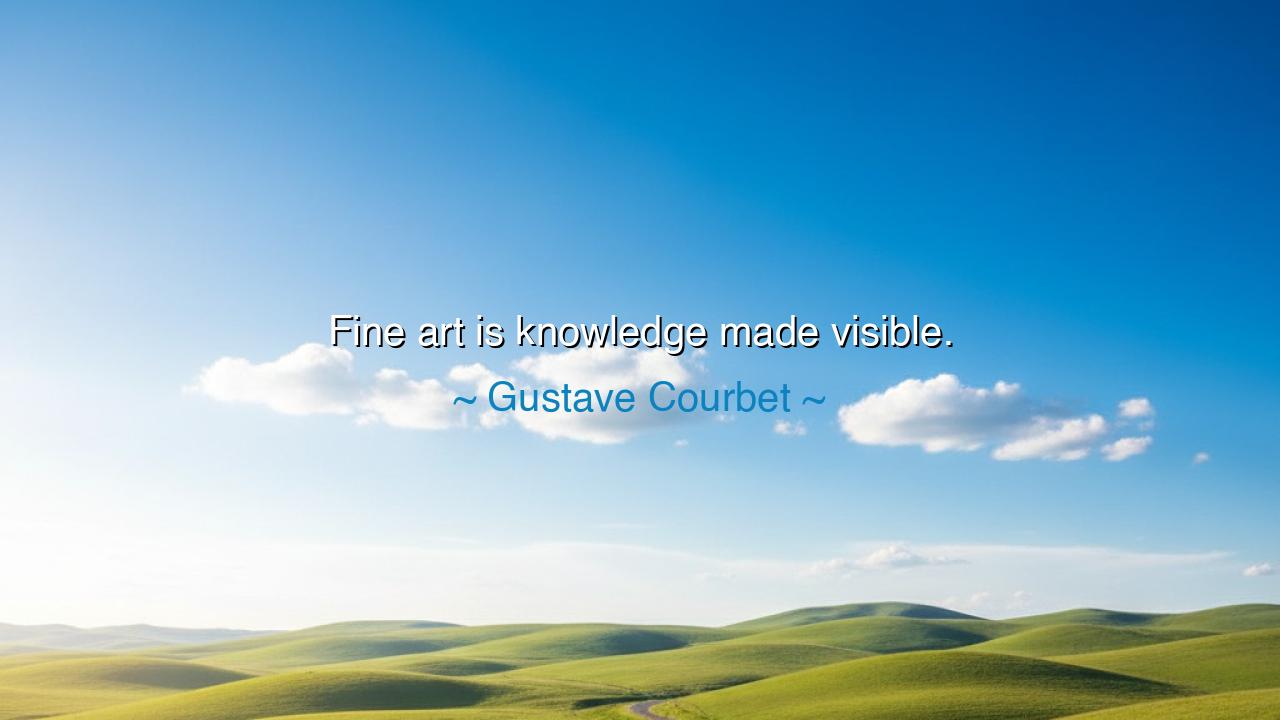
Fine art is knowledge made visible.






The words of Gustave Courbet, the revolutionary painter of France, ring with a timeless clarity: “Fine art is knowledge made visible.” In these few words, he unveiled a truth that echoes through the halls of human history—that art is not mere ornament, nor idle play of colors, but the incarnation of wisdom, experience, and truth upon the canvas of the world. What the sage contemplates in silence, the artist renders in form; what the philosopher writes in words, the painter makes flesh through light and shadow. Thus, fine art is the great bridge between the unseen mind and the visible eye.
To understand Courbet’s conviction, we must remember the world in which he lived. In the 19th century, art was often bound in chains of idealism, where painters sought to escape reality in favor of myths and illusions. But Courbet, the father of Realism, rejected such escape. He declared that art must reveal truth, that it must embody the knowledge of the earth, the people, and the age in which it was born. In every peasant’s face, in every stone and tree, he saw wisdom waiting to be revealed. For him, the task of the artist was not to flatter or deceive, but to make visible the truths that often lay hidden in plain sight.
Consider the story of Leonardo da Vinci, the great master of both science and art. When he painted “The Last Supper,” he did not merely depict men at a table. He made visible the trembling of the soul—the betrayal lurking in Judas’ hand, the sorrow in Christ’s gaze, the astonishment in the apostles’ faces. His art was not decoration; it was knowledge of human nature, of light, of proportion, of divine mystery, given shape in pigment and plaster. What might have remained locked in the vault of the mind was made eternal through the power of art.
This is why tyrants have always feared the artist. A weapon may slay a body, but fine art unmasks the spirit of an age. When Goya painted “The Third of May,” he made the cruelty of war visible, exposing injustice in a way no proclamation could silence. When Picasso gave to the world “Guernica,” he revealed the horror of bombed villages, and his canvas became a cry against tyranny. In every age, art becomes the memory of a people, a visible library of their struggles, triumphs, and sorrows. Such art is not mere craft, but knowledge made visible—a knowledge so powerful it cannot be destroyed even by fire or time.
O children of the future, hear this well: fine art is more than beauty. It is a mirror held to truth, a revelation of wisdom, a vessel of memory. To look upon it with careless eyes is to miss its gift. To create it with careless hands is to betray its purpose. But to approach it with reverence is to glimpse eternity. For in every true work of art, knowledge is not spoken, but shown; not argued, but embodied.
The lesson for us is clear. Seek to see knowledge in the visible world: in the fold of a garment, in the wrinkle of a brow, in the dance of sunlight upon water. Cherish art not as a luxury, but as a teacher. Support those who dare to paint truth, even when their truth is uncomfortable, for they are guardians of wisdom in a world that forgets too quickly. And if you are called to create, let your work not flatter vanity, but reveal the knowledge that lies beneath appearances.
Practical action awaits you: visit the galleries and museums not as a tourist but as a pilgrim; keep a sketchbook or journal where you practice the art of seeing; study the works of great masters and ask not “Is this beautiful?” but “What knowledge is made visible here?” In doing so, you train your eyes to see the invisible woven into the visible, and your heart will become attuned to the wisdom of the ages.
Thus let Courbet’s words endure: “Fine art is knowledge made visible.” Remember them whenever you stand before a painting, a sculpture, or a building carved by human hands. For every true work of art is a fragment of eternal wisdom given form, a flame of truth that will outlast both its maker and its beholder. And if you would live wisely, let your eyes never cease to seek that hidden knowledge, made visible before you.






AAdministratorAdministrator
Welcome, honored guests. Please leave a comment, we will respond soon